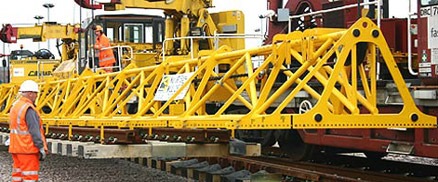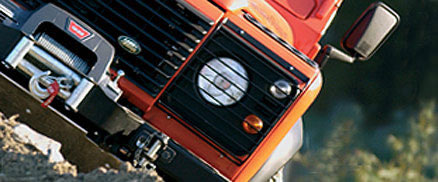April 1st, 2011
Slings are available in different sizes, different materials and different widths. You can buy slings in single, two, three and four leg form. Below are the different types of slings that are available.
Roundslings
Roundslings are an endless loop of yarn which are covered by a woven tubular jacket. One advantage to round slings is that all of the load-bearing yarns are protected by this jacket. Round slings use polyester load yarns that are protected by a double wall, polyester cover. Sizes larger than this use an abrasion-resistant nylon, double wall jacket. All round sling jackets are color-coded along industry standards to indicate their capacity rating. While the standard configuration is endless, they are also available in eye & eye and braided styles.
Most roundslings have high strength, Aramid fibers for their load bearing yarns. These slings are the strongest and lightest slings in the world, with the lowest sling weight per capacity rating. Orange colored, double wall jackets for all sizes indicate that these slings have Aramid load bearing yarns. Tuff-Tags are standard on these, and all synthetic slings.
Wire Rope Slings
Wire Rope Slings are mainly found at construction sites because of their low cost and resistance to abrasion in construction work environments. High tensile strength steel wires are combined in various constructions to form ropes with specific characteristics. Standard constructions for slings are referred to as 6X19 or 6X36, designating the total number of wires being used. The greater the number of wires, the greater the flexibility and the lower the resistance to abrasion. Typical sling ropes use 6X19 in the smaller diameters and 6X37 at 1 ¼” diameter and larger.
Eye & Eye style slings are the most popular, but numerous end fittings are available to suit specific needs.
Chain Slings
The most appropriate type of sling that is used in extreme conditions where a normal sling would not last. Typical environment would be foundries and steel mills. Material used in chain slings is typically high strength alloy specific for the lifting industry.
Posted in Arbil Lifting Gear |
April 1st, 2011
Buying a snatch strap is not just a case of buying the first one that you see. Careful research needs to be conducted and it is imperative you purchase a snatch strap with the correct rating. A snatch strap whose breaking strength is light will break under the load it is pulling, whereas a strap that has a heavy breaking strength will be unable to stretch correctly, causing damage and stress to the recovery points and even injury.
A formula needs to be used when buying a snatch strap. This formula determines the correct minimum breaking strength of the strap. The correct strength should be between 2 and 3 times the gross vehicle mass of the lighter of the two vehicles being used in the recovery process. It is important that you only use industry standard equipment when recovering a vehicle and that the snatch strap is of the correct rating.
Never be under the misconception that you will never find yourself in dire straits stuck in mud. If you off road in your 4×4 then chances are you will get stuck. Having the snatch strap as part of your recovery gear will save the day and you will never leave home without one again.
Posted in Arbil 4x4 |
April 1st, 2011
K 1250 Rail Cutter
The petrol powered K1250 Rail is an entire rail cutter all the way from the engine to the cutting arm and fixture. This cutting saw is light, robust and flexible and does not compromise on quality, durability or reliability.
K 1260 Rail Cutter
With its 119cc (5.8kW) motor, the K 1260 is the world’s strongest rail-cutter. It also weighs in at 5kg less than its competitors in the same power class. The K 1260 Rail is capable of using both 14in and 16in blades. Fitted with double fixture attachments, this enables the operator to turn the machine and cut from the other direction. This means you can cut rails faster than ever, while letting the cutter do the work. The rail cutter is, in spite of the amazing power developed, surprisingly easy to control, thanks to its balanced construction and ergonomic design.
Specifications of the K 1260 Rail:
- Air-cooled two-cycle engine
- 119cc displacement
- 5.8kW power
- • Weight (without fuel or blade, inc. RA 10): 20.7kg (14in), 21.4kg (16in)
- Blade diameter: 350mm (14in), 400mm (16in)
- Cutting depth: 125mm (5in), 145mm (6in)
Having a stable fixture provides precise cuts. The arms of the patented RA 10 and RA 10 S fixture are short, and its joints have needle and ball bearings for the best stability possible. This not only makes the machine compact and easy to control, but also results in precise cuts on all levels. The rail saw attachment is fitted to the rail quickly and firmly. It provides right-angle cuts in all positions, with a folding guide to mark the exact location. The optional RA10S with a clamping width of up to 135mm is designed for the wider tram railway rail.
Posted in Arbil Rail |
February 23rd, 2011
Camlok lifting clamps are the most suited clamps to use for all UK rail track currently in use. The clamps are suitable for lifting beams, rail tracks and other sections of track. The range of Camlok clamps have been designed to lift in a secure and safe way. Currently Camlok offer a wide range of clamps suitable for the rail industry.
CR – Single Rail Clamp
This clamp is designed with a narrow profile which enables safe attachment to individual rail that is stacked side by side with other rails. Once the clamp is positioned it is locked onto the rail-head by using a lever operated spring mechanism. If the rail track is of a longer length then these clamps should be suspended from a lifting beam to operate at full potential.
RP – Rail Pulling Clamp
A rail pulling clamp fits almost most rail sections. This clamp is designed to be used when positioning rail sections. It has a screw shaft mechanism which is used to attach the clamp to the web of the rail. At the end of the screw shaft are hardened steel circular teeth and the opposing pad also has hardened circular steel teeth for a strong grip.
The shaft is supported on a bearing that allows a high degree of angular movement. When a lateral load is applied to the clamp, the pad rotates in a cam action and securely grips the rail web securely and safely.
Posted in Arbil Rail |
February 23rd, 2011
Although chain slings are designed for rugged, lasting service, precautions should be observed to extend the product’s useful life. Certain hazards are inherent in the operation of chain slings and users must exercise intelligence, care and common sense to ensure a safe working environment.
- Never exceed the working load limit of a chain sling.
- All fittings and attachments must have a working load limit (WLL) equal to or greater than that of the chain; if not, the assembly must be rated at the WLL of the weakest component.
- Do not rest or drop load on chain.
- Eliminate all twists, knots or kinks before lifting.
- Do not point load hooks – load should be seated properly within throat opening and centered in bowl of the hook.
- Balance the load to avoid undue stress on one leg of multi-leg slings.
- Use pads around sharp corners.
- Do not use in acid solutions. Consult manufacturer for recommendations.
- If possible, avoid extreme temperatures (under 20 degrees F or over 350 degrees F).
- Temporary and permanent reductions to working load limits occur when chain slings are used at high temperatures.
- Return slings to manufacturer to ensure proper repair procedures are followed.
- Clean chain slings regularly since dirt and grit can cause wear at link bearing points.
- Protect chain from corrosion.
- Store chain slings in a clean, dry area, preferably by hanging on racks or A-frames; slings stored on floors are subject to abuse.
Posted in Arbil Lifting Gear |


